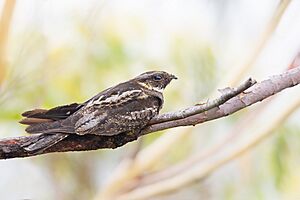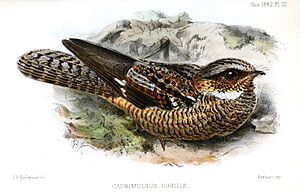White-throated nightjar facts for kids
Quick facts for kids White-throated nightjar |
|
|---|---|
 |
|
| Conservation status | |
| Scientific classification | |
| Genus: |
Eurostopodus
|
| Species: |
mystacalis
|
| Synonyms | |
|
White-throated Goat-sucker, White-throated eared nightjar |
|
The white-throated nightjar (Eurostopodus mystacalis) is a special bird that belongs to the nightjar family. It lives only in eastern Australia. In winter, it visits Papua New Guinea for a short time. This bird loves to live in warm, dry forests.
Contents
About the White-Throated Nightjar
How Scientists Name Them
Scientists sometimes change how they name and group animals. The white-throated nightjar used to have a different scientific name, Eurstopodus albogularis. Now, its main name is E. mystacalis.
This bird was once thought to be the same species as the New Caledonian nightjar and the Solomons nightjar. But later, scientists found that these three birds had different calls and looked a bit different. So, they were made into separate species.
What Their Name Means
The first part of its scientific name, Eurostopodus, comes from ancient Greek words. Eurostos means 'strong', and podos or pous means 'foot'.
The second part, mystacalis, comes from Latin and means 'moustache'. This might be because of the markings near its beak!
What They Look Like
The white-throated nightjar is the biggest nightjar in Australia. It grows to be about 30 to 37 centimeters long. Both male and female birds look very similar.
Their bodies are dark with many different patterns. Their upper body and wings are brownish-grey with dark streaks and spots. Their belly is spotted brown or greyish-white with reddish-brown bars.
They have a creamy-yellow neck. A large white patch on each side of their throat makes it look like they are wearing a collar. The four outer feathers on their wings have a clear white spot. This helps tell them apart from other nightjars. Their tail is brown with black speckles and no white. They have a greyish-black beak and short, dark brown legs. These short legs make it hard for them to walk on the ground.
When they fly, their wings are long and pointed. They hold their wings above their head. These birds fly in a bouncy way, often gliding with a double wing beat.
Where They Live and Travel
The white-throated nightjar lives only in eastern Australia. Birds that live in northeast Australia stay there all year. Birds from the south travel there to breed.
They are found mostly in New South Wales and Queensland. In winter, from February to April, many birds fly to Papua New Guinea. They go there for the winter but do not breed there. Some birds do stay in northern and central Queensland all year.
These birds can live in many different places. But they are most often found in dry forests that are not too high up. They like to nest and rest in dry woodlands with not too many plants on the ground. Many have been found in woodlands that have had forest fires. In New South Wales, they have been seen near the edges of rainforests and mangroves.
Birds that spend winter in New Guinea can be found in savannas, open grasslands, forest edges, marshlands, and gardens. They might also be found along the beaches of the Solomon Islands.
Behaviour
Sounds and Calls
You might hear white-throated nightjars more often than you see them. They have a special song that helps tell them apart from other birds. Males usually sing a series of fast, bubbling notes. Their song sounds like wow-wow-wow-wow-ho-ho ho-ho-o-o-O. It has 9 to 12 notes and lasts for three to six seconds. When singing, the bird puffs out the white patch on its throat. Females sometimes sing too. This song is mostly heard at dawn or dusk. It stops once the breeding season is over.
Their call is also very clear. It sounds like an rising whook whook whook for about ten notes. Then it speeds up into a 'cackle of laughter'.
Adult birds talk to their young with low, husky notes. Young chicks make harsh khaah notes. But they will cheep when they want food. If their nest or chicks are in danger, parents can make loud barks, tocks, and hisses to distract threats. During courtship, both males and females make low croaks and snap their beaks at each other.
What They Eat
This bird hunts for food while flying, mostly at night. They catch many different kinds of flying insects. Their diet includes mantises, crickets, grasshoppers, beetles, and winged ants. But large moths are their favorite food.
They might hunt in groups of 20 or more birds, especially when they are migrating. When they migrate, they travel during the day. This lets them have more time to hunt at night.
Reproduction and Life Cycle
The breeding season is from September to February. But it can be a bit different depending on the area. In southern Australia, it is mainly from October to December. In the Solomon Islands, it is October to November. In New Caledonia, it is August to September.
During courtship, males chase females and show off. Both birds also make calls to each other. Males often land on low branches and wave their wings up and down while calling.
White-throated nightjars do not build nests. Instead, they lay their eggs right on fallen leaves or bare soil. Their eggs are pale yellow with purplish-brown spots. They usually lay only one egg at a time. They like to nest on hilltops or stony ridges. They often use the same nesting spots every year.
Both parents help raise the young. They take turns sitting on the egg. During the day, the female sits on the egg while the male stays nearby. At night, the male takes over. This lets the female go hunt for food.
If the nest or chick is in danger, parents will try to distract the threat. They might take short flights, make hissing and barking sounds, or flick their tails while on the ground. The egg hatches after 29 to 33 days. Newly hatched chicks can move around on their first day. After about 30 days, the chick learns to fly. Females might lay another egg three weeks after the first one hatches. If an egg is lost, females will lay another to replace it. They can lay up to 5 eggs in one breeding season.
Conservation
Even though the white-throated nightjar is not currently in great danger, their numbers are slowly going down. These birds often fly along roads at night looking for food. This can lead to them being hit by cars. Wild cats and dogs also hunt both adult birds and chicks.
Fire ants (Wasmannia auropunctata) were brought into the area in the 1970s. They have spread into the nightjar's home and threaten young chicks. Also, more bushfires have burned large parts of the Melaleuca savanna. This destroys places where the birds can live. We do not know the exact number of these birds left.



